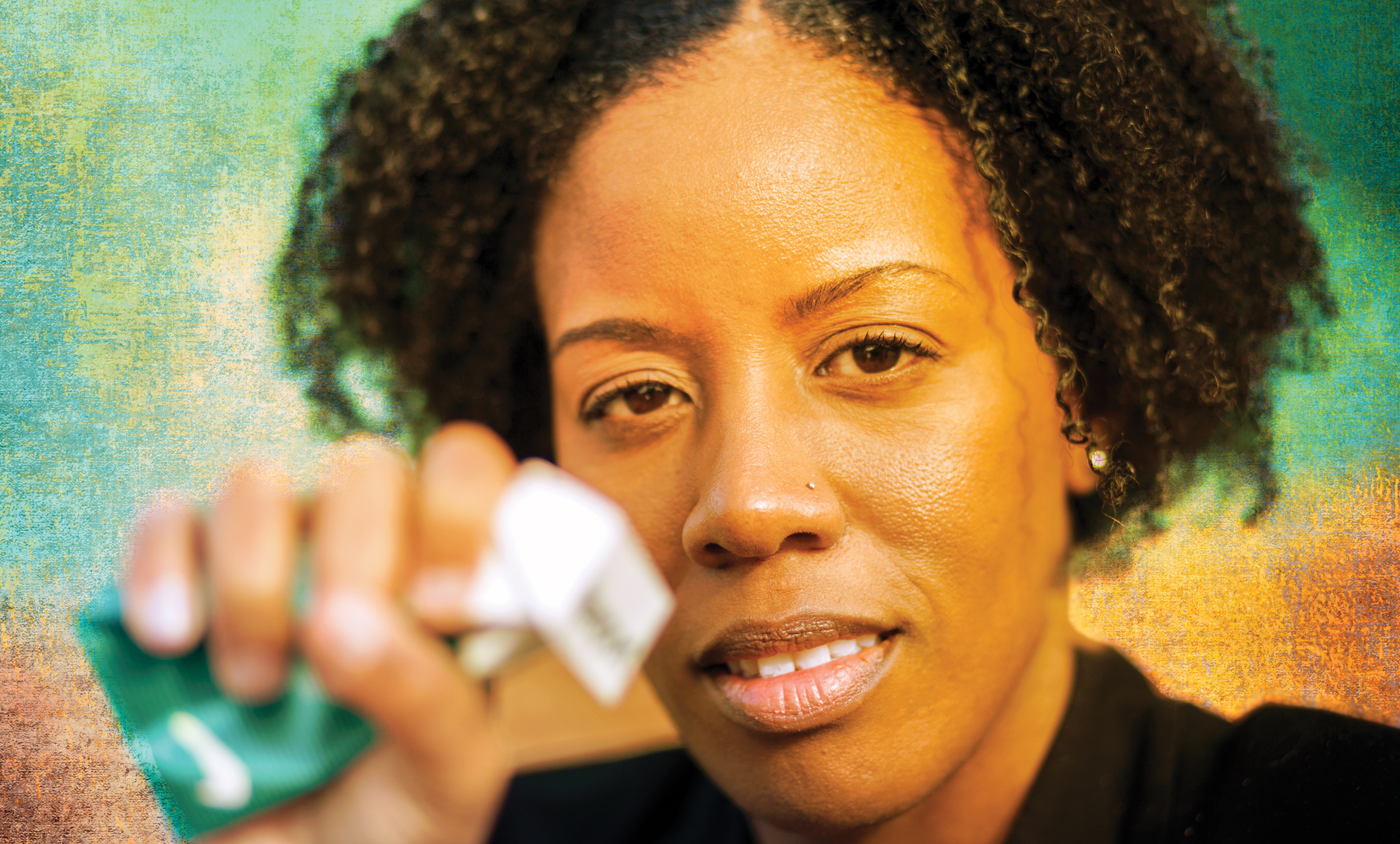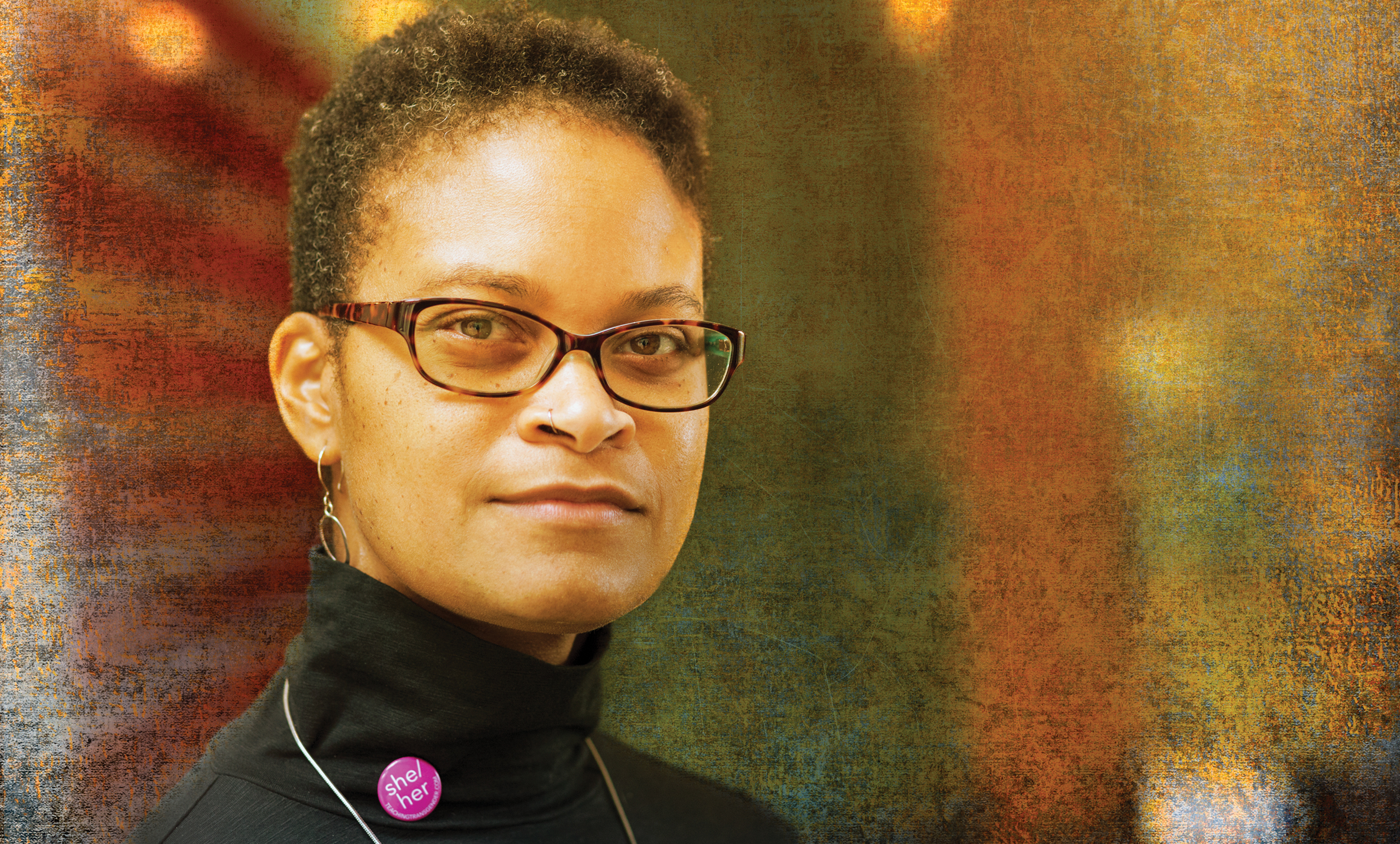Bridging Cancer’s Great Divide
Six epidemiologists seek to eliminate disparities in cancer incidence and outcomes.

Disproportionately Deadly Cigarettes
Why do African Americans have higher rates of smoking-related cancers even though they smoke fewer cigarettes per day than their white counterparts?
Miranda Jones, PhD ’13, MHS ’10, was scouring national health data when a possible answer emerged.
Jones’s research, published in PLOS ONE in 2013, suggested that menthol cigarettes, which are particularly popular in black communities, could be to blame. “Previous studies on smoking-related cancers didn’t think about the idea that black smokers are not smoking the same type of cigarettes,” she says.
The mounting evidence against menthol cigarettes led Jones, an assistant professor in Epidemiology, to shift her focus from secondhand tobacco smoke exposure to the hazards of menthol cigarettes and their role in health disparities by race.
Smoking + Cancer
Although African-American men smoke less than white men, they are 37 percent more likely to develop lung cancer than white men.
SOURCE: AMERICAN LUNG ASSOCIATION
Menthol’s “cooling” qualities may encourage deeper inhalation and absorption of toxins. A 2013 study by Jones published in Cancer Epidemiology, Biomarkers & Prevention supports this theory. She found higher levels of the toxic metal cadmium in menthol cigarette users’ blood than in the blood of nonmenthol cigarette smokers.
Her interviews with black smokers in Baltimore offer useful insights on why menthol cigarettes remain popular. Many choose menthols because their parents and peers did. And smokers often assume that cigarettes with menthol are healthier because the compound is found in cough drops and other health aids, Jones says.
Understanding why black smokers stick with menthol cigarettes is the first step to designing an intervention, Jones says. “You have to drill down—from broader questions to questions specific to a community—to address behaviors that could be handed down from one generation to the next,” she says.
Capitalizing on close-knit relationships in black communities is one promising approach to reducing menthol use. “It could be as simple as educating one individual about health risks who will in turn educate others in the community,” she says.
Beyond effective education campaigns, Jones has found that a key policy change could make her job much easier. In conversations with black smokers devoted to their menthols, she has picked up hints of a possible behavior change: Some have told her that if menthol cigarettes were banned, they would quit smoking altogether.

Social Determinants of Survivorship
There are 3.5 million breast cancer survivors in the United States, [but] after a diagnosis, we don’t know what happens 20 years down the line,” says Lorraine T. Dean, ScD, an assistant professor in Epidemiology.
As survivors age, their needs for medical and social support change—but the data necessary to understand and meet those evolving needs are scarce.
Dean’s findings so far point to marked health disparities for black cancer survivors that threaten their long-term health and quality of life. For example, in a 2016 study in the Journal of Obesity, Dean found that black women suffered more severe lymphedema (swelling in the arms and legs caused by the removal of lymph nodes during cancer treatment) than white women. Previous studies had attributed these differences to black women’s higher body mass, but Dean’s study showed that among women with high body mass, the differences were driven instead by socioeconomic position, highlighting the interplay of race and socioeconomic disparities in health outcomes after cancer.
Ethnicity + Breast Cancer
Despite similar incidence rates, breast cancer death rates in the U.S. are 42 percent higher in black women than white women.
SOURCE: AMERICAN CANCER SOCIETY
Dean’s work on aging breast cancer survivors takes into account the same social disadvantages, such as poor access to care and low income, that are linked to a range of other health disparities, including black women’s higher breast cancer mortality rate. Dean examines such disparities through the lens of social determinants of survivorship, which considers “how social and economic factors influence women’s risk of getting additional diseases or their ability to manage those secondary diseases,” she says.
For instance, African-American women are the largest—and lowest-paid—demographic group of women in the workforce. Economic pressures make it difficult for black women to manage their disease. “If you’re in a low-income job, think about your ability to take time off when you have a cancer diagnosis, to have adequate insurance and adequate care,” Dean says. Interventions such as a temporary freeze on a patient’s mortgage payment while she’s in active treatment could provide much needed breathing room.
Addressing these underlying socioeconomic disparities, Dean says, “is a way of solving some of the racial disparities we have in cancer.”

A Viral Connection to Cancer
Gregory Kirk, MD, PhD ’03, MPH ’95, first encountered the ravages of the hepatitis B epidemic as a graduate student in The Gambia in West Africa. Now a professor in Epidemiology, he explores how the HIV and hepatitis viruses rapidly progress to cancer and other diseases in underserved communities in Africa and Baltimore.
In Baltimore, he investigates relationships among HIV, hepatitis C and cancer in a cohort of injection drug users through the AIDS Linked to the Intravenous Experience (ALIVE) study. The study has recruited more than 5,000 people since 1988, many of whom are homeless and have limited access to care.
Kirk’s research has shown that this population is at risk for both HIV-related cancers such as Kaposi’s sarcoma and non-Hodgkin’s lymphoma, and several cancers not related to HIV, including liver and lung cancer. In fact, those who are HIV-positive are several times more likely to develop and die from lung cancer than comparable people who are HIV-negative, even after accounting for smoking, Kirk and colleagues first reported in a 2007 study published in Clinical Infectious Diseases.
hiv + liver cancer
People infected with HIV are three times more likely to be diagnosed with liver cancer, probably because of a higher rate of co-infection with hepatitis B or C.
SOURCE: NATIONAL CANCER INSTITUTE
About a quarter of those in his study are infected with both hepatitis C and HIV, which increases their risk for liver cancer. In a study published in Annals of Internal Medicine in 2015, Kirk and his colleagues demonstrated that HIV accelerates liver damage caused by hepatitis C by nearly a decade, hastening cancer.
Despite advances in hepatitis C therapies, barriers to treatment are formidable for the people in his study, Kirk says. Conditions such as mental illness, homelessness and drug use interfere with treatment access and adherence, he says. Patients with hepatitis C are often denied treatment until they are diagnosed with moderate fibrosis, which can lead to liver cancer, according to a study by Kirk and other researchers published last year in Clinical Infectious Diseases.
Delaying treatment can be fatal. “If we were to treat the infection at an early stage, it’s much less likely to progress to highly lethal liver cancer,” Kirk says. He is now leading similar work focused on identifying and treating earlier-stage disease among Ugandan patients with HIV and hepatitis B infection.

Uncounted, Unseen and Undiagnosed
Stigma breeds cancer disparities, says Tonia Poteat, PhD ’12, MPH, MSc, who studies the health issues of transgender people. Transgender men who still have a cervix may be turned away by gynecologists, raising their risk for undiagnosed cervical cancer. They may skip medical appointments to escape the humiliation of being called by the wrong name or pronoun.
“When you think about where people go to get a Pap smear—they’re sitting in the waiting room. At a minimum, transgender men are going to get stares, and health care providers might not understand why they should be there,” says Poteat, an assistant professor in Epidemiology.
The little research that exists suggests that people who are transgender face particular and often overlooked health risks. For example, HPV was detected in 40 percent of trans men and women in a study conducted in Italy. High rates of HPV infection mean a greater risk for HPV-related cancers, but trans men and women are rarely treated as a discrete population in cancer surveillance systems. As a result, HPV screening and vaccination guidelines for the trans community are unclear and inconsistent, according to a study Poteat co-authored in LGBT Health in 2017.
Transgender Issues
A survey of OB/GYNs found that 35 percent and 29 percent felt comfortable caring for transgender women and men, respectively.
SOURCE: JOURNAL OF WOMEN'S HEALTH, FEBRUARY 2015
Poteat is also investigating whether sexual orientation can further exacerbate disparities in breast cancer outcomes for black women. She and colleague Lorraine Dean (see Social Determinants of Survivorship) received a grant to conduct in-depth interviews with 30 black lesbians who have had a breast cancer diagnosis or abnormal mammogram.
“There are significant data that black women are more likely to die” of breast cancer, Poteat says. “We want to know what that looks like for black sexual-minority women. We are having conversations with them about engaging in the health care system and the barriers that exist.”
Although most of Poteat’s research focuses on reducing disparities for gender- and sexual-minority people living with and at risk for HIV, she says the same interventions apply to cancer disparities. “I train health care providers to be more welcoming and explain what they need to know about providing competent care for trans people and the barriers to getting them in the exam room.”

An Unequal Burden of Risk
Although risk factors for breast cancer vary widely among racial and ethnic groups, older health disparity studies often did not include Hispanic women. This exclusion amounted to missed opportunities to save lives, says Avonne Connor, PhD, MPH, an assistant professor in Epidemiology.
As a doctoral candidate and postdoc at the University of Louisville and later as faculty at the Bloomberg School, Connor mined data from population-based studies to understand why Hispanic women with breast cancer risk and specific comorbidities such as obesity, diabetes and hypertension are more likely to die than non-Hispanic white women with the same conditions. Connor and her colleagues recently observed that Hispanic women are almost two times more likely to die from breast cancer if they have a history of diabetes.
She has now turned her attention to mitigating those conditions for African-American breast cancer survivors in Baltimore, where the higher incidence of chronic illness and poor access to care disproportionately decrease survivorship of African-American women compared to white women.
Nutrition + Breast Cancer
Women who live in neighborhoods with more unhealthy food outlets have a 10 percent higher risk of breast cancer.
SOURCE: CANCER EPIDEMIOLOGY BIOMARKERS & PREVENTION, APRIL 2017
“I’d like to make an impact for women in Baltimore who are considered to be high risk for breast cancer incidence and mortality based on individual health status, their level of obesity and [other] comorbidities, and environmental factors” such as high crime rates and lack of recreational spaces, Connor says.
Her biggest challenge lies in locating the women she wants to help. In collaboration with the Johns Hopkins Center to Reduce Cancer Disparities, she seeks to identify breast cancer survivors through local partnerships that bridge the gap between researchers and the community. With guidance from colleagues who research HIV in Baltimore, Connor is also developing new methods, such as word-of-mouth appeals and handing out surveys at sites frequented by women, to recruit study members reluctant to discuss their breast cancer diagnosis.
Her work could have a significant ripple effect. If interventions like healthier diets and exercise succeed among her study cohort, they may also improve the health of loved ones and neighbors. “We’re not only targeting breast cancer survivors for interventions, but figuring out how we can transfer what we find to their families and other high-risk women,” Connor says.

Reality-Checking the Data
The disparity was hiding in plain sight.
Anne Rositch, PhD, MSPH, was analyzing cervical cancer data when she exposed a glaring gap in mortality rates between white and black women. The mathematical model that informed cervical cancer screening guidelines in the U.S., she realized, didn’t account for the one in five women in the U.S. who have had a hysterectomy and were therefore not at risk for cervical cancer.
When women with hysterectomies were excluded from the data, the death rate for white women rose by 47 percent. For black women, it rose by 77 percent. Rositch and colleagues found that the previously unadjusted data underestimated the death rate disparity between black and white women by 44 percent.
The study, published last year in Cancer, also determined that the cervical cancer death rate was highest in women over age 65, when guidelines say screening for the disease is no longer necessary if a woman has had prior and negative screening. Rositch’s study drew national attention and sent a message that current cervical cancer screening guidelines don’t account for the adjusted mortality rates and may fail many more black and older women than previously thought.
Ethnicity + Cervical Cancer
Black women are twice as likely to die from cervical cancer than white women.
SOURCE: AMERICAN CANCER SOCIETY
In an earlier study that also corrected for hysterectomies, Rositch found a higher rate of cervical cancer among women ages 60 to 65 than previously believed. Published in Cancer in 2014, the study got pushback from the medical community for recommending a review of cervical cancer screening guidelines for women 65 and older.
Rositch, an assistant professor in Epidemiology, does most of her research in sub-Saharan Africa, where cancer incidence and mortality are soaring as developing African nations Westernize. For example, Tanzania has experienced a steep rise in breast cancer rates, a trend made more grim by a 50 percent survival rate. The Susan G. Komen breast cancer foundation recently awarded Rositch a grant to improve breast cancer outcomes in that country.
The study’s first phase “is just to see if we can accumulate accurate data on the current situation. ... Then we can better figure out how to address it,” Rositch says.
Her previous experiences have made her hopeful. “Once you start to see the data,” she says, “a million patterns and potential solutions arise.”
